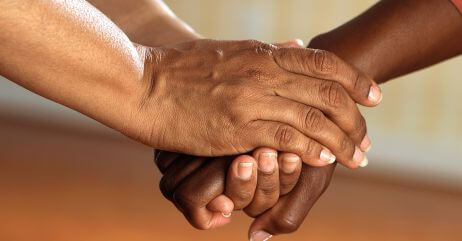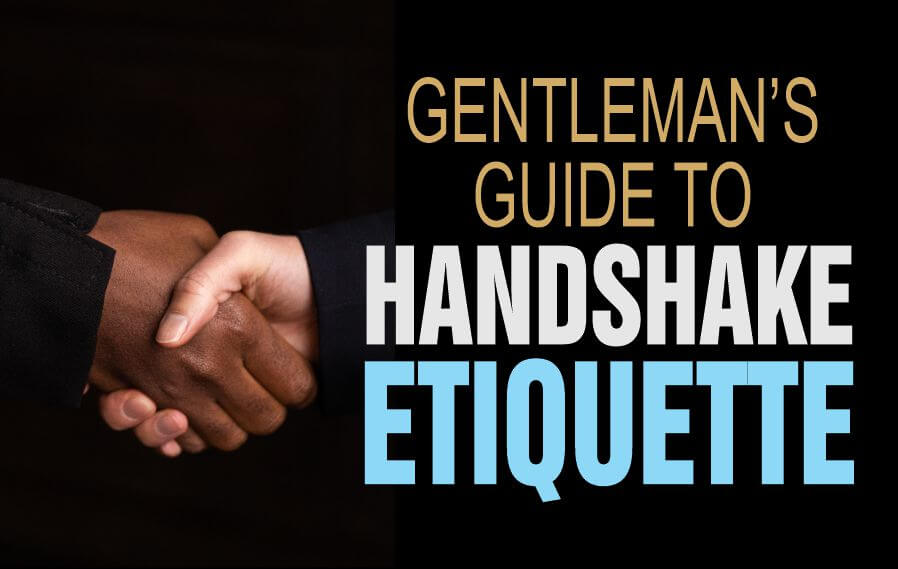Last updated on January 31st, 2025 at 08:36 am
Personality and manners reflect in handshakes and this is why every man should master the handshake etiquette for great first impressions.
Handshake as one of the gentleman’s etiquettes is a topic that people seldom talk about, but it’s one of the little things that mean much to humans.
Just like the act of kissing a hand, a gentleman’s handshake is more than just a simple gesture; it is a mirror of his conduct and the confidence he exudes.
In this guide, we will explore the dos and don’ts, the nuances, and the unspoken rules that will help you leave a lasting impression in both professional and social settings.
From the firmness of the grip to the duration of the shake, we will lay bare, the details of this age-old tradition.
Table of Contents
- What is Handshake Etiquette?
- Importance of a Handshake in Establishing a First Impression
- How to Approach a Person in Hand Shake
- Elements of a Good Handshake
- Reading Your Handshake Partner
- The Dos and Don’ts of Handshaking
- Handshake Mistakes to Avoid
- Handshakes in Professional Settings
- Woman Handshake Etiquette
- Handshaking in Social Situations
- Conclusion
- Frequently Asked Questions
What is Handshake Etiquette?
Handshake etiquette is the set of social norms and guidelines, written or unwritten that govern the appropriate way to greet and interact with others through the act of shaking hands.
It is a culturally significant gesture that serves as a form of non-verbal communication, conveying various messages such as respect, professionalism, trust, and friendliness.
Handshake etiquette takes into consideration factors such as grip strength, eye contact, timing, duration, and overall demeanor during the handshake.
Related: Gentleman’s Guide to Driving Etiquette
Importance of a Handshake in Establishing a First Impression
A handshake holds immense importance in establishing a positive and lasting first impression.
This initial physical contact often occurs within the first few moments of meeting someone and can set the tone for the entire interaction.
Here’s why the handshake is so crucial:
- Non-Verbal Communication: A handshake speaks volumes about your personality and intentions. A strong, confident grip exudes self-assurance, while a weak, limp one may signal uncertainty or disinterest.
- Professionalism and Respect: In business, a proper handshake showcases professionalism and respect. It signals a commitment to the interaction and willingness to engage in a meaningful exchange, reflecting seriousness.
- Trust Building: A sincere handshake can establish a foundation of trust between individuals. When you offer your hand for a handshake and receive one in return, it signifies a mutual willingness to engage and collaborate.
- Confidence: A strong handshake highlights your confidence and assertiveness, leaving a positive impression of your self-assured demeanor. Vital for job interviews, networking, and meetings.
Related: Gentleman’s Guide to Dining Etiquette
- Memorability: People are more likely to remember interactions that involve physical contact, and a handshake can contribute to making you more memorable to the person you’re meeting.
- Cultural Universality: Despite cultural differences, handshaking remains a universally recognized symbol of goodwill and respect. Mastering proper etiquette aids in navigating diverse social and professional contexts, locally and globally.
- Immediate Connection: A handshake establishes a sense of immediate connection between individuals. It bridges the gap between strangers and initiates a personal connection that can lead to more open and productive communication.
How to Approach a Person in Hand Shake
When approaching a person for a handshake, make sure you maintain eye contact and approach them with a confident and friendly gesture.
Extend your right hand firmly, but not too aggressively, towards theirs.
Make sure your hand is open and your fingers are together.
Grasp their hand firmly and shake it up and down a few times. Be sure to match their grip strength.
Smile and give a nod of acknowledgment as you shake hands. Make sure to release their hand after a few seconds.
Remember to keep the handshake professional and respectful, avoiding any overly dominant or weak gestures.
Elements of a Good Handshake

A good handshake is a blend of several key elements that convey respect, confidence, and professionalism.
These components ensure that the gesture is meaningful and impactful in various social and professional interactions.
- Proper Hand Placement: The positioning of your hand during a handshake is crucial. Aim for a middle ground between a bone-crushing grip and a weak touch. A balanced grip reflects respect and consideration, allowing both parties to feel comfortable and acknowledged.
- Eye Contact: Maintaining eye contact while shaking hands amplifies the sincerity of the gesture. It demonstrates genuine interest, confidence, and respect. Engaging visually shows that you’re fully present and focused on the interaction.
Also Read: Gentleman’s Guide to Napkin Etiquette
- Firmness of Grip: A firm handshake strikes a balance between confidence and aggression. Your grip should be strong enough to exude self-assuredness, yet not overpowering. This balance communicates competence and approachability.
- Timing and Duration of the Handshake: Timing is essential; offer your hand when you make eye contact and when the introduction occurs. The duration should be brief but not abrupt, lasting around two to three seconds. This ensures a comfortable and respectful exchange.
- Palm Orientation: Your palm should be vertical, neither facing up nor down, to create a neutral, balanced impression. Avoid holding the other person’s hand too tightly or too loosely. This orientation indicates equality and mutual respect.
Incorporating these elements into your handshake enhances your ability to make positive impressions and effectively navigate a variety of social and professional situations.
Reading Your Handshake Partner

Reading your handshake partner involves paying attention to subtle cues during the handshake, which can offer insights into their feelings, personality, and intentions.
By observing these cues, you can better understand the dynamics of the interaction and adapt your own behaviour accordingly.
Interpreting Different Handshakes and Their Meaning
Different handshakes carry distinct meanings. A firm, confident grip usually indicates self-assuredness and confidence.
A limp handshake might imply hesitation or discomfort. An overly strong grip might suggest dominance.
By discerning these nuances, you can grasp the other person’s attitude and adjust your response accordingly.
Also Read: Gentleman’s Guide to Toasting Etiquette
Adjusting Your Handshake Based on Cultural Differences
Cultural norms influence handshake styles. In some cultures, a gentle grip is preferred, while others value a stronger grip.
Some cultures use both hands or a bow instead of a handshake. Being aware of these differences and adapting your handshake accordingly demonstrates respect for the other person’s culture.
Recognizing and Responding to Non-verbal Cues During a Handshake
During a handshake, non-verbal cues, like facial expressions and body language, offer insights into your partner’s comfort level and feelings.
A smile and direct eye contact may indicate warmth and openness. If someone avoids eye contact, they might be nervous or disinterested.
Being attuned to these cues helps you adjust your behaviour and create a more comfortable interaction.
Related: How to Dress Like a Gentleman
The Dos and Don’ts of Handshaking

Following proper handshake etiquette enhances your interactions and leaves positive impressions.
Here are the dos and don’ts of handshaking:
Dos
Make Eye Contact: Establish eye contact to convey sincerity and engagement. It shows you’re fully present and interested in the interaction.
Smile and Greet Warmly: A genuine smile and warm greeting create a friendly atmosphere. It helps put your handshake partner at ease and promotes a positive start.
Match the Strength of Your Grip: Gauge your partner’s grip and mirror their strength. A balanced grip reflects consideration and adaptability, ensuring comfort for both.
Shake Hands for About 2-3 Seconds: Maintain the handshake for a brief yet respectful duration, around 2 to 3 seconds. This shows enthusiasm without lingering excessively.
Related: Gentleman’s Guide to Chat Etiquette
Don’ts
Offer a Limp or Weak Handshake: A weak handshake can be interpreted as a lack of confidence or interest. Aim for a balanced grip to project self-assuredness.
Squeeze Too Hard, Causing Discomfort: An overly strong grip might come across as aggressive or dominant. Strive for firmness without causing discomfort.
Hold Onto the Handshake for Too Long: Prolonged handshakes can lead to awkwardness. Keep the duration respectful to avoid making your partner uncomfortable.
Forget to Release Your Hand After the Shake: Remember to release the handshake gracefully. Holding on after it’s concluded can be awkward and convey reluctance.
Mastering these dos and avoiding the don’ts ensures that your handshakes convey respect, confidence, and openness, promoting positive connections.
Related: Gentleman’s Guide to Social Media Etiquette
Handshake Mistakes to Avoid
Certain mistakes can undermine the effectiveness of the handshake gesture. Here are some common handshake mistakes to steer clear of:
- The Sweaty or Clammy Handshake: A sweaty or clammy handshake causes discomfort and signals nervousness. Ensure dry hands by using a tissue or discreetly wiping them before shaking hands to avoid this misstep.
- The Finger-Only Handshake: Offering only your fingers in a handshake is perceived as insincere or dismissive. Presenting your entire hand signifies genuine interest and respect. Avoid this mistake by extending your hand fully.
- The Awkward Multiple Attempt Handshake: Multiple attempts to align your handshake can lead to awkwardness. If you misjudge the approach, gracefully correct it without drawing excessive attention. Being composed demonstrates adaptability.
- The Overly Dominant, Overly Aggressive Handshake: An overly dominant or aggressive handshake, often referred to as a “bone-crusher,” can be uncomfortable and off-putting. Strive for a firm but balanced grip to convey confidence without overpowering the other person.
Related: Gentleman’s Guide to Walking Etiquette
Handshakes in Professional Settings

Handshakes in professional and business settings serve as a fundamental tool for building connections, displaying confidence, and showcasing professionalism.
They convey essential non-verbal cues that can influence how you’re perceived in various professional interactions.
Importance of a Professional Handshake in Networking and Job Interviews
A professional handshake is critical in networking and job interviews. It’s the initial point of physical contact that can leave a lasting impression.
In networking, it creates a strong first impression, while in job interviews, it conveys your enthusiasm and professionalism.
Tips for Handshakes in Business Settings
- Firmness and Balance: Strike a firm but balanced grip to exhibit confidence without being overbearing.
- Eye Contact: Maintain eye contact during the handshake to communicate sincerity and engagement.
- Appropriate Timing: Offer your hand when introductions occur to demonstrate readiness and attentiveness.
- Duration: Keep the handshake brief, around 2-3 seconds, to avoid awkwardness.
- Palm Orientation: Maintain a neutral palm orientation for equality and respect.
- Adapt to Culture: Be aware of cultural variations in handshake styles and adapt accordingly.
- Confidence: Exude self-assuredness while avoiding overly dominant grips that might make others uncomfortable.
Professional Handshake Etiquette, Gender, and Power Dynamics
Navigating gender and power dynamics in professional handshakes requires sensitivity.
Treat everyone equally regardless of gender. Aim for a consistent approach, offering the same grip to all.
Focus on professionalism over gender-related considerations. In situations involving power dynamics, ensure your handshake is respectful and appropriate for the context, without being overly aggressive.
In professional settings, a handshake is more than a mere greeting—it’s a statement of competence, confidence, and respect.
By mastering professional handshake etiquette, you can enhance your networking, job interviews, and overall interactions, promoting strong relationships and successful engagements.
Related: Netiquette and How a Gentleman Can Observe it
Woman Handshake Etiquette

Woman handshake etiquette involves extending a confident, balanced grip with appropriate eye contact and a warm greeting.
Respect cultural differences and personal boundaries.
Show equality in professional interactions, and be attuned to non-verbal cues for a respectful and positive handshake experience.
However, because of some religious and cultural factors, there might be a shift in the handshake.
The key is to pay attention to cues and adjust accordingly.
Related: Wine Etiquettes Every Gentleman Should Know
Handshake Etiquette with Woman
Gentlemen engaging in a handshake with a woman should prioritize respect and professionalism.
Extend a firm handshake, striking a balance between strength and gentleness.
Maintain appropriate eye contact and greet warmly. Adapt to cultural diversity by being mindful of different customs.
Treat the woman as an equal professional, emphasizing her role and expertise.
Respect personal boundaries; some women might prefer a softer grip. Pay attention to non-verbal cues and adjust your approach accordingly.
Your demeanor during the handshake showcases your courtesy, cultural awareness, and social sensitivity, contributing to positive and respectful interactions in various contexts.
Who Should Offer Handshake First, Man or Woman?
In modern times, the tradition of who initiates a handshake has become more flexible.
Gender is no longer a sole determinant. Instead, the person with higher social status, the host, or the one introducing themselves often takes the lead. It’s about courtesy, equality, and context.
Adapting to cultural norms and respecting individual preferences promotes inclusive and respectful interactions.
Related: How to Maintain Personal Boundary Etiquette
Handshaking in Social Situations
Handshakes are observed almost unconsciously in social situations and it’s safe to say it’s casual.
However, for the gentleman, all handshake etiquette should be taken into consideration.
Here are some angles to consider:
Handshake Alternatives for Casual or Informal Settings
In casual or informal settings, you can opt for alternatives to a formal handshake.
A friendly nod, a wave, or a simple verbal greeting can suffice. These gestures maintain a sense of connection without the formality of a handshake.
Greeting New Acquaintances with a Handshake
When meeting new acquaintances, a handshake helps break the ice. Extend a warm grip, accompanied by eye contact and a genuine smile.
This initial contact sets a friendly tone for the interaction and makes others feel welcome.
Related: RSVPing the Right Way
Engaging in the Gentlemanly Gesture of Hand-Kissing
Hand-kissing, while less common today, is a traditional gesture of courtesy. In some cultures, especially in formal settings, a gentleman might gently kiss a woman’s hand.
If aware of its cultural context, this can be a respectful display of politeness and chivalry.
Conclusion
In navigating the gentleman’s guide to handshake etiquette, we’ve covered pivotal aspects.
A well-executed handshake speaks volumes about your confidence and professionalism.
Whether in business settings, networking, or daily encounters, this gesture leaves a lasting impression.
As gentlemen, let’s remember that a handshake bridges gaps and establishes connections.
Practice and refine these skills to exude confidence and warmth. With every handshake, we convey respect, courtesy, and the timeless art of meaningful human interaction.
So, embrace the power of a handshake, and let it symbolize your dedication to confident and respectful interactions.
Frequently Asked Questions
What are the 3 rules of the handshake?
A firm grip, eye contact, and a genuine smile constitute the three fundamental rules of a proper handshake.
What is the proper handshake etiquette?
Maintain eye contact, offer a balanced grip, and smile warmly to show respect, confidence, and professionalism.
How do you shake hands like a gentleman?
Extend a firm but not overpowering grip, make eye contact, and offer a friendly smile while acknowledging the person’s presence.
What are the 5 best practices when giving a handshake?
- Firm grip
- Eye contact
- Appropriate timing
- Neutral palm orientation
- Brief duration
Who should shake hands first?
It varies; generally, the person with higher status, the host, or the one initiating the introduction should extend their hand first.
What makes a strong handshake?
A strong handshake balances firmness with respect, reflecting confidence, competence, and engagement.
What are 3 things a handshake should not be?
A handshake should not be weak, overly dominant, or overly prolonged; a handshake should avoid discomfort, aggression, or awkwardness.
What are the mistakes in handshakes?
Common mistakes include weak grips, excessive force, prolonged duration, lack of eye contact, and not respecting personal space.
How do you start a handshake?
Approach with a friendly demeanor, extend your hand with a balanced grip and make eye contact as you initiate the handshake.
References:
Pyo Merez is a men’s lifestyle enthusiast and writer about the gentleman’s place and impact on society. Raised by a distinguished gentleman dad, he offers unique insights into how the mind of a gentleman works and how societal norms shape gentlemen’s identity and vice versa.
Through his insightful articles, Pyo taps into the depths of gentleman culture to provide perspectives on etiquette and manners in modern society.

